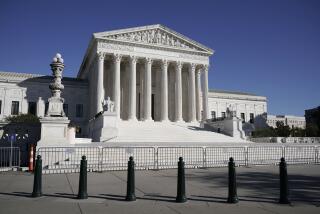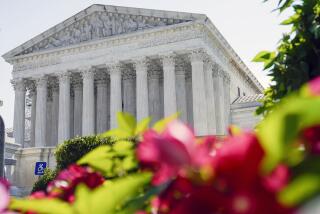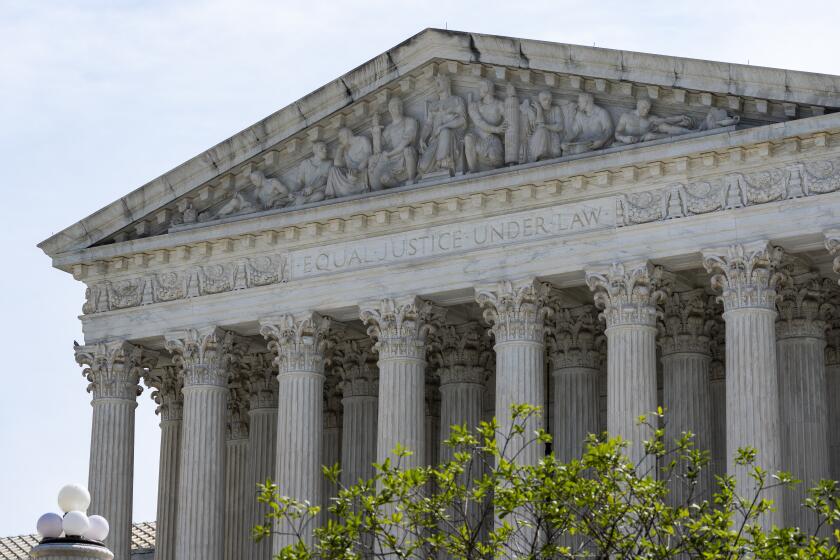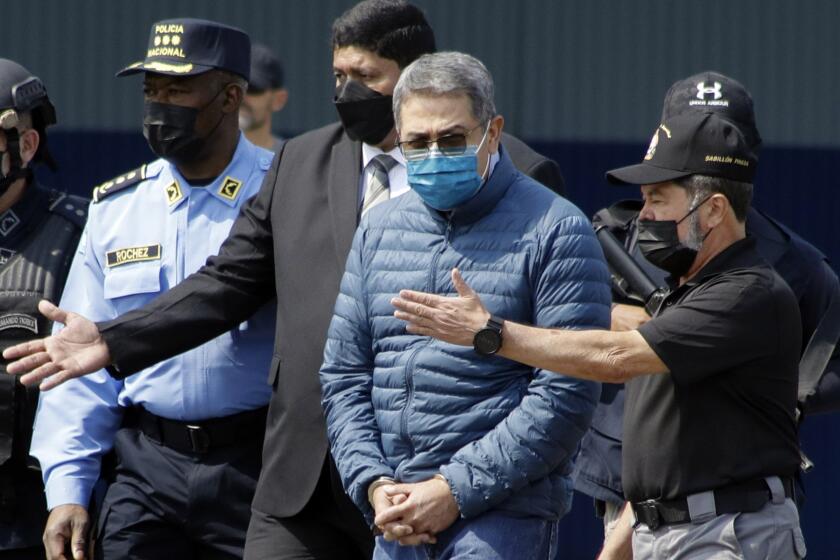Bahrain security forces assault sleeping protesters in capital square
Security forces in tiny but strategic Bahrain launched a brutal assault early Thursday against at least 1,000 defiant anti-government protesters, including women and children, camped out in tents in the capital’s Pearl Square.
A barrage of tear gas canisters thundered across the square about 3 a.m. as dozens of police cars, armored security vehicles and ambulances converged on the makeshift tent city in the center of Manama that was beginning to resemble a smaller version of Tahrir Square in Cairo, where Egyptian protesters overthrew their president.
Most of the protesters in Pearl Square were asleep when attacked, witnesses said, noting that no steps had been taken to guard the area, even though two people had been killed in earlier clashes with authorities.
“They told us we had three days in the square,” said one man as he ran from the scene. “And then they attack us on the second day.”
Flashing blue police car lights cast an eerie strobe effect down side streets and a helicopter swooped overhead, as packs of young men with bandannas covering their faces against the clouds of gas fled. They flashed “V” signs and shouted slogans and warnings.
“Get away, they’ll shoot you, they’ll shoot anyone they think is Bahraini,” some called. Security forces in Bahrain are often recruited from neighboring nations or Southeast Asia.
Other weeping escapees told of seeing women and children lying passed out from the fumes.
“I was sleeping and then I heard screaming,” said protester Alla Mutawa. “They attacked children, they used gas that choked you like you were dying.”
In the wake of the attack, hundreds of wailing relatives packed the halls and lobby of Salmaniya Medical Complex, creating pandemonium as they frantically searched for loved ones amid the chaos. Medical officials said they had seen at least one older man and a younger man killed by rubber bullets and at least 50 people, including toddlers, were being treated for injuries. They said they expected the toll to rise.
Relatives crowded into a room where the two bodies were draped by bloody sheets. One woman in a black abiya pounded the walls and herself, keening and screaming, “Our heart! Our souls! Our martyrs!”
“We were shouting, ‘Peaceful, peaceful,’ ” in an imitation of the Tahrir Square protesters, a woman said as she tearfully held a small child being treated with oxygen in a hallway. “Tomorrow the king will say, ‘Sorry,’ but this was done with his permission. He is the one telling these men to do these things.”
Nurse Zainab Yousef Hassan said she was working in a clinic in the square when “they came from everywhere, so many police, and began beating doctors.”
She showed a vicious bite mark on her arm, saying she clubbed and bitten by a police officer as she tried escape. She finally managed to grab two children who were in the clinic and ran to a mosque before making her way to the hospital to treat the injured there.
As a stream of ambulances continued to roll up and unload the wounded onto a river of gurneys, an angry crowd began to throw fists into the air and chant, “Enough, enough.”
The protesters had set up camp in the square -- some bringing their families -- to signal their intent to stay until King Hamed ibn Isa Khalifa forced his uncle to step down as prime minister and guaranteed an end to discrimination and repression.
Unlike the heavily nationalist revolts in Egypt and Tunisa, Bahrain’s unrest is rooted in the discrimination felt by the poor Shiite majority at the hands of a a governing Sunni royal family. The island nation of about 740,000 people is also crucial to U.S. interests in the region: It hosts the U.S. Navy’s 5th Fleet.
The demands of protesters have grown over three days, with the crowd now torn between those who want constitutional reforms and others who say openly that they want the family of the king to step down.
Bahrain’s protest movement appears to be largely leaderless, although medical and media centers have been organized by the demonstrators. Some credit the use of Facebook, Twitter and blogs with providing a forum for activists to trade ideas and promote the rally.
Before Thursday’s crackdown, the unrest in Bahrain had emerged as among the most potent anti-government force in a string of sometimes lethal demonstrations sweeping the Middle East, importing the lessons of North Africa’s recent uprisings into the oil-rich Persian Gulf.
The successful uprisings in Tunisia and Egypt have become models for a daily phenomenon in places like Yemen and Bahrain. With new marches planned in several other countries over the next several days, including Morocco and Libya, governments from North Africa to the Gulf were settling in for what looks to be an extended period of instability.
One of the more volatile fronts is Libya. Anti-government protests erupted in several towns across Libya on Wednesday, with reports of police stations torched in the cities of Qubba, Zentan and Baida, and overnight clashes in Benghazi on Tuesday.
The most serious reports of violence in Libya remained unconfirmed because the government of Moammar Kadafi imposes heavy restrictions on the operations of journalists.
Opposition activists reported on social media that police had opened fire with live ammunition on demonstrators in Baida and Benghazi. At least five people died in the violence, which broke out a day before the biggest street demonstrations -- billed as a “Day of Rage” -- planned for Thursday in the North African nation.
Street fighting in Benghazi began Tuesday night, when protesters gathered in response to the arrest of a well-known human rights lawyer became agitated at reports of a fire inside Abu Selim military prison. Many outside the prison were awaiting the release of family members, said Libyan journalist Fatthi Ben Eissa in a telephone interview.
“It started out with a few tens of families. That became 300 demonstrators in a few minutes, and very quickly escalated to 2,000,” said Mohammed Ali Abdallah, deputy secretary general of the exiled opposition group, the National Front for the Salvation of Libya.
Opposition groups reported a widening series of protests in towns across Libya, including several in which police stations were burned.
Abdallah said his group is urging the departure of Kadafi and the institution of a constitutional form of government in Libya, but said the widening protests inside the country are not associated with any organized political faction.
On Wednesday, protests in Yemen spread to the southern port city of Aden, where police opened fire in an attempt to break up a surging crowd, killing two.
Al Jazeera Television reported that about 500 protesters hurled stones at police, set cars on fire and stormed a municipal building before gunshots were heard and tear gas was fired.
In Sana, the capital, a sixth straight day of protests turned violent Wednesday in another round of clashes between about 800 students seeking the ouster of President Ali Abdullah Saleh and young people loyal to the regime who were carrying clubs, stones and daggers. At least four people were wounded, Reuters news agency reported.
In Iran, government supporters paraded through the streets bearing the coffin of a 21-year-old Tehran Art University student Saane Zhaleh, killed during a march Monday by tens of thousands of Iranians seeking the ouster of the theocratic regime.
Described by the government as the “martyr Basij,” Zhaleh is said by the authorities to have been killed by government opponents when he joined Basiji militiamen to help put down the protests, which were officially prohibited by the government. The opposition says he supported the anti-government protesters and was shot by police.
State television showed marchers carrying Iranian flags and shouting slogans against opposition leaders Mehdi Karroubi and Hossein Mousavi, including “Death to Karroubi!” and “Death to Mosavi!” There were brief clashes with opposition activists, but no injuries, according to state TV.
Iran also officially confirmed the death of a second “passerby” at Monday’s protests, 22-year-old Mohammad Mokhtari, who according to the Iranian Fars news agency was “wounded by a number of rioters” during Monday’s events.
In Jordan, the latest in a series of largely peaceful protests was staged by about 150 people in the rain outside one of King Abdullah II’s palaces, where labor activists and teachers demanded a return to a constitution that more evenly divides power between the king and the parliament.
kim.murphy@latimes.com ned.parker@latimes.com Times staff writers Murphy reported from Amman and Parker from Manama. Special correspondent Meris Lutz in Beirut and Amro Hassan of the Times’ Cairo bureau contributed to this report.
More to Read
Start your day right
Sign up for Essential California for news, features and recommendations from the L.A. Times and beyond in your inbox six days a week.
You may occasionally receive promotional content from the Los Angeles Times.






